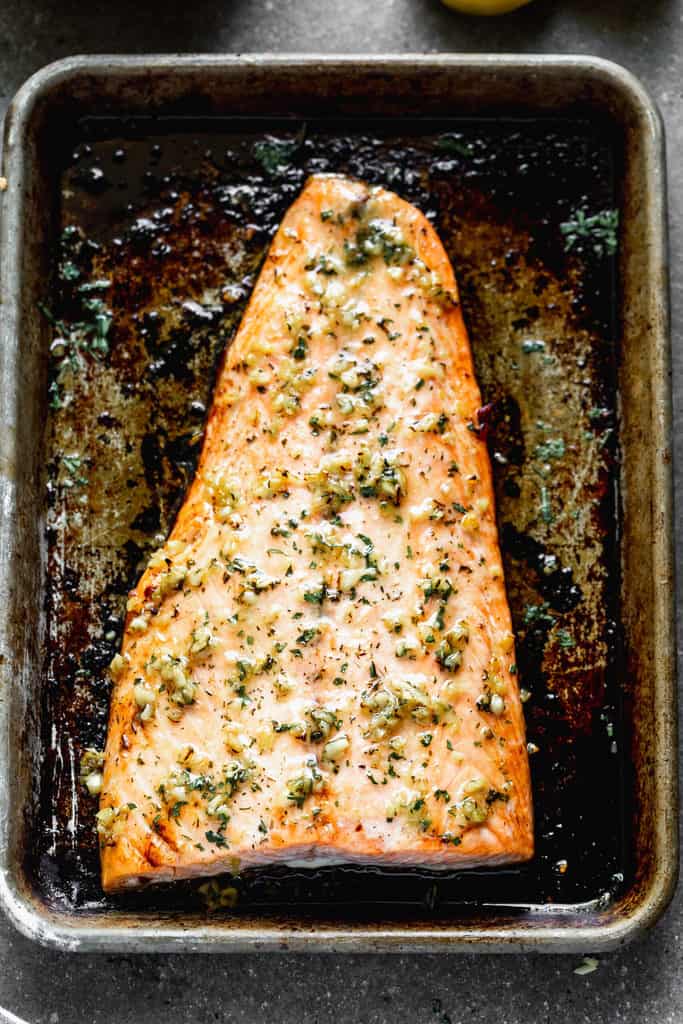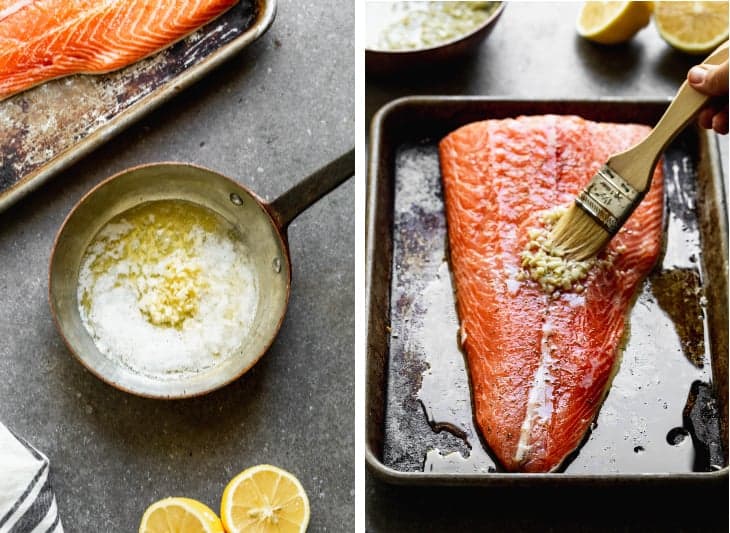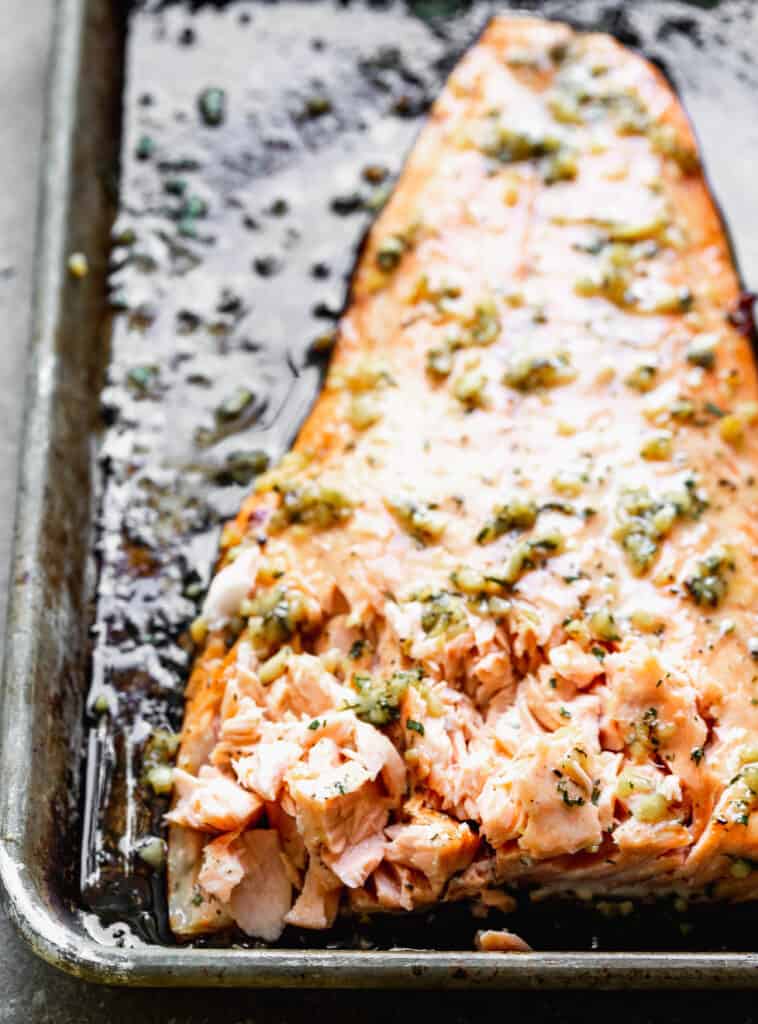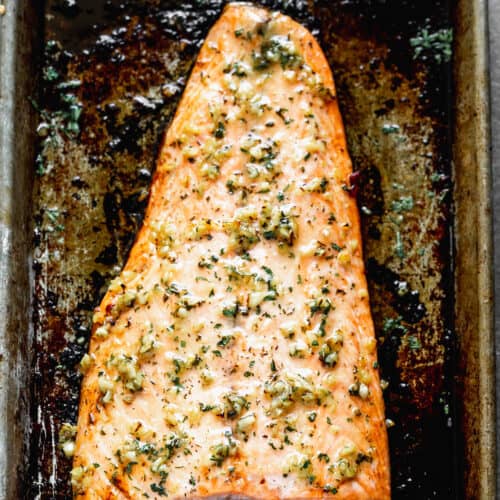Looking for more seafood recipes? Try my Easy Homemade Crab Cakes, Seared Scallops, or learn How to Cook Crab Legs!
Why I love this recipe:
Healthy – You can’t beat a fillet of perfectly cooked salmon next to a nice salad or roasted vegetables. It’s delicious and leaves you feeling full of energy! Easy – Follow my step-by-step instructions and tips you won’t believe how easy perfectly cooked salmon can be! Versatile – I have included three different seasoning options for you to choose from, and you can also choose to bake the salmon in foil or on a sheet pan.
Do’s and Dont’s for Baked Salmon:
DO Buy High Quality Salmon. There are several types of salmon, including: King salmon (Chinook), silver salmon (coho), pink salmon (humpback), red salmon (sockeye), and Atlantic salmon. Any of these types of salmon can taste delicious baked in the oven. DOCheck for Freshness. Salmon filet– if you are buying a salmon filet at the store, choose a filet with firm flesh. Give it a poke! Gently press the fillet with your finger and if it springs back, this is a good sign. If you’r fingerprint lingers in the fillet, choose a fresher fish. Also, look for a brightly orange-red hue in the fillet and nicely marbled skin. Look for darkening around the edges of the fish or brown/yellow discoloration in the flesh of the fish. These are NOT signs of freshness. Whole Salmon – First look in its eyes–no really! Take a look at the eyes of the salmon and choose a salmon with clear, bright eyes over cloudy, sunken eyes. Clear eyes is a good indicator of freshness. When you hold the fish, also look for the flesh to feel firm, not floppy. Smell the fish! This is a huge indicator of freshness! You want to avoid salmon that has a strong fishy smell. It should have a mild, salt-water or sea smell.
DOThaw Salmon Properly. Fresh fish- After purchasing fresh fish, store it in the refrigerator until ready to use (it typically should be used within two days). Before baking, be sure to let the fish sit at on the counter until it comes to room temperature. This will allow it to cook more evenly. Frozen fish- to thaw frozen fish, either let it say in the refrigerator overnight or, for a quicker defrost, place it in a sealed bag under cold running water until thawed. It’s important not to use hot water or any type of heat to that your salmon! Allow it to come to room temperature before baking. DO Remove the Bones, If Needed. Before baking, gently run your fingers over the fillet of the fish to feel for ends of the bones that may be sticking out. If you notice bones, you can use needle-nose pliers to carefully remove them. DOSeason It, But Not Too Soon! Unlike beef and chicken where we love to apply a marinade for an hour or longer, with salmon, we don’t want to add the seasoning (particularly salt) too early. salt will may draw out to much moisture if left for an extended period of time. For best results, season salmon just before baking. In the recipe card you will notice I’ve provided 3 of my favorite salmon seasonings; Lemon and dill, garlic butter, and cajun seasoning.
DON’T Rinse Salmon. Washing your raw fish is unnecessary, and may spread bacteria to your sink or other parts of your kitchen. Any bacteria that may reside on the fish will be killed when it’s cooked in the hot oven. Also, water can can break down the flesh of the salmon. Instead of rinsing with water, gently pat the salmon all over with a paper towel. DON’T Remove the Skin Before Baking. Most people prefer their salmon without the skin, however you should still leave the skin on your salmon until you’ve baked it. Always bake salmon with the skin side down as this will help protect the fillet from the heat of the pan and it will help the salmon retain its juices and cook evenly. When it’s time to serve the salmon, the skin will come off really easily as you slide a spatula between the fillet and the skin. DON’T Overcook. Possibly the worst thing you can do is over cook your salmon. Most restaurants serve salmon medium rare though some prefer it cooked a little longer. Ideally, remove salmon from the oven before it’s “done” as it will continue cooking while it rests. Cook time will vary as salmon fillets vary in thickness. If you have a thermometer, aim for about 140 degrees F (per USDA recommendations). You can also check for doneness by using a sharp knife and peeking inside the thickest part of the fillet. It should look opaque and the layers within the salmon should flake apart easily.
Recipe Variations:
Garlic Butter – a mixture of garlic, butter, chicken broth, lemon juice, and honey. Lemon & Dill – a mixture of butter, lemon juice, lemon zest, garlic, dill, salt, and pepper Cajun Seasoning – I love McCormick’s Cajun seasoning! Baked Teriyaki Salmon – Pour some Teriyaki Sauce on top of the salmon before baking! Cedar Plank Salmon. Air Fryer Salmon: We love cooking Salmon in the air fryer, and Well Plated has an amazing recipe! Grill Salmon: if you want to learn How to Grill Salmon, Fit Foodie Finds has a great recipe.
Serve With:
Roasted Vegetables or Hericot Verts Classic Wedge Salad or Tomato Cucumber Salad Perfect Mashed Potatoes Garlic Knots or the Best Homemade Rolls Fresh Fruit Salad On a Buddha Bowl
*I originally shared this recipe September 2013. Updated October 2019 and March 2022.
This post contains affiliate links.



